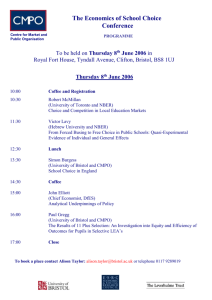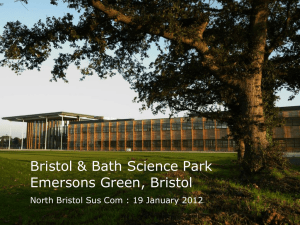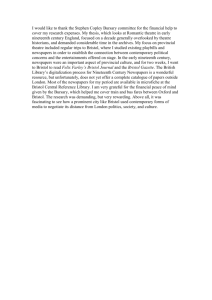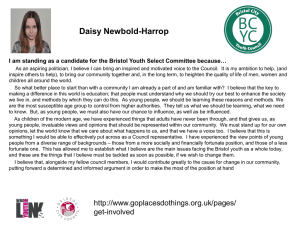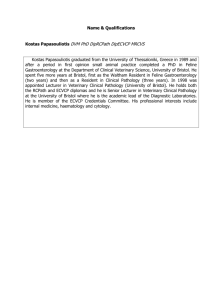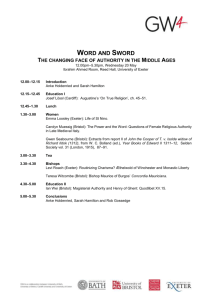Notes from 1st workshop on Bristol community strategy for energy
advertisement
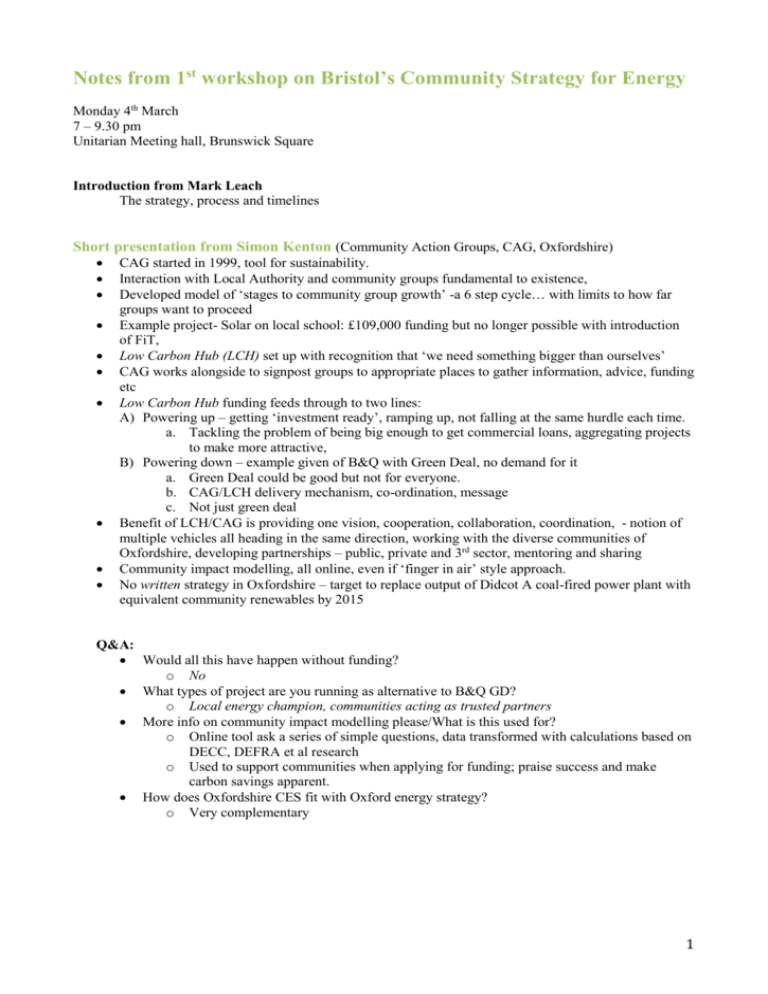
Notes from 1st workshop on Bristol’s Community Strategy for Energy Monday 4th March 7 – 9.30 pm Unitarian Meeting hall, Brunswick Square Introduction from Mark Leach The strategy, process and timelines Short presentation from Simon Kenton (Community Action Groups, CAG, Oxfordshire) CAG started in 1999, tool for sustainability. Interaction with Local Authority and community groups fundamental to existence, Developed model of ‘stages to community group growth’ -a 6 step cycle… with limits to how far groups want to proceed Example project- Solar on local school: £109,000 funding but no longer possible with introduction of FiT, Low Carbon Hub (LCH) set up with recognition that ‘we need something bigger than ourselves’ CAG works alongside to signpost groups to appropriate places to gather information, advice, funding etc Low Carbon Hub funding feeds through to two lines: A) Powering up – getting ‘investment ready’, ramping up, not falling at the same hurdle each time. a. Tackling the problem of being big enough to get commercial loans, aggregating projects to make more attractive, B) Powering down – example given of B&Q with Green Deal, no demand for it a. Green Deal could be good but not for everyone. b. CAG/LCH delivery mechanism, co-ordination, message c. Not just green deal Benefit of LCH/CAG is providing one vision, cooperation, collaboration, coordination, - notion of multiple vehicles all heading in the same direction, working with the diverse communities of Oxfordshire, developing partnerships – public, private and 3rd sector, mentoring and sharing Community impact modelling, all online, even if ‘finger in air’ style approach. No written strategy in Oxfordshire – target to replace output of Didcot A coal-fired power plant with equivalent community renewables by 2015 Q&A: Would all this have happen without funding? o No What types of project are you running as alternative to B&Q GD? o Local energy champion, communities acting as trusted partners More info on community impact modelling please/What is this used for? o Online tool ask a series of simple questions, data transformed with calculations based on DECC, DEFRA et al research o Used to support communities when applying for funding; praise success and make carbon savings apparent. How does Oxfordshire CES fit with Oxford energy strategy? o Very complementary 1 Rapid-fire sessions 1. Strengths Short intro from Martin Fodor: the nature of community energy; essentially it’s about choosing degree of community involvement, ie the same technologies or activities can be delivered with either more or less community role, involvement and benefits on a spectrum. This could be a test of the city’s energy strategy: to what extent it builds a community role into delivery. Ideas/suggestions from floor on strengths of community approach: - Understand local area, access to market, rely on the community - Funding community action, tackling fuel poverty, ensuring employment generation, & training local people - Voluntary stuff can make something viable where otherwise its not, /make things happen when not financially viable - Motivation will be greater for action, - Reducing consumption, and where simple economic says its not a profitable business it can work for a community initiative; - Trusted groups, they are starting from a different point - Flexibility to be more creative- they starting from different points, can try things out, case by case which could become bigger, - Local references, impact of Bristol Green Doors, learning from neighbours, - Its not about the bottom line for communities - Building sense of community also matters when projects are implemented - Ability to gather local support, support from local people, - Medium to long term horizons, gives more action over long term linking with long term of issue of climate change, - Community projects consider wider benefits and potential to spend money more effectively, - Potential to add significant contribution to local community, example of nuclear in France, groups more likely to find appropriate contribution to local people. - Groups have much more joined up approach. - Unlocking skills of communities. Releasing potential, - Due to knowledge know how to spend money better, - ‘Your own pigs don’t smell’ - local buy in. 2. Opportunities: Short intro from Caroline Bird: groups and ‘brokers’ (intermediary organisations eg BEN, CSE)‘looking up’ to govt opportunities and identifying local possibilities and ‘looking down’ to interact relevantly with local population and pooling skills. Ideas/suggestions from floor on opportunities for communities: - Customers become next sales force / advocates, e.g. ‘tuppaware parties’, - Skills, community involvement, courses need to be accredited for max value, skills for employability in a very practical sense. - Working with statutory agencies, working together becomes more important. Voting with their feet, - Having evidence of what works - Speak to peoples concerns in ways government can’t – leading to positive action - Utilise physical things, move away from text and number and engage in other forms of engagement and communication, eg visual - (SK reference) aggregate positive outcomes to boost profile, - collectively we can do much better, - Not keen on: ‘looking up and looking down’ phrases, - Street by street approaches will become more important as time goes by - Linking with other community style or ish projects locally, not going for normal candidates, - When they have experience with success, opportunity to pose more difficult questions, push org.s harder to create better answers. - can make policy demands (more so than eg council) 2 - Partner with local business, Shape discourse and narrative at community level and looking up to govt. important given scale of challenge, conveying risk is important. Working together, integration of local communities, community cohesion 3. Threats: Short intro from Caroline Bird: lack of resources (funding and people), information, expertise; barriers in population understanding; need to co-ordinate with other groups Ideas/suggestions from floor on threats to communities: - Lack of distinction between community group and energy supplier - muddying waters by association with big business - ‘Shininess factor’- people go with what is exciting, people trust things that are most exciting, - Different age groups, over 65 easy split, different outlook for older and young people - Funding as threat - groups don’t have funding and time, lack of continual engagement weakens their performance/credibility, lack of consistency due to lack of resources - Lack of experience in self organising, - Potential for failure, leading to lack of trust / loss of reputation and credibility - Danger of being subsumed by govt policy, big society, those that offer critique become subservient to others, - Reliance on volunteer effort – potential for burn-out,(we’re told burn-out is massive threat in Oxford) - Attrition from what is really needed, eg Groups being EON badged, losing core values - Random rapid funding --> poorly thought through projects – eg funding from DECC to be spent in 3 weeks.. - Possibility to be derailed from initial intentions by commercial interests / corporate finance - Is energy too big a sector to ever be effective in makingmuch change / influence on a community level, will we always be up against it? 4. Weaknesses: Short intro from Caroline Bird: mapping exercise from last BEN meeting. Highlights include: householders seem to be outside of the loop at the moment, geographical mapping of groups (Bristol map); local businesses that aren’t being linked to enough; connecting through schools, housing groups, libraries, … Ideas/suggestions from floor on weaknesses to community approach: - Bristol is essentially villages that happened to be close to each other, i.e. differing strong attitudes and values in different areas; housing stocks are different in different areas, - Limited resources and skills in communities for developing projects, don’t have chance to engage others. - Should we be encouraging or fostering groups in deprived areas. Maybe aspirations but not skills to support funding bids, - Different demographics, - challenge to groups - Problem in not being able to see wood from trees – ie what others are doing? – sharing knowledge of initiatives across the city. Next level above would be good to see - Engaging geographically, deliberate decisions to target areas, (eg. Lockleaze - go through neighbourhood partnerships, found enthusiasm and engagement, people were up for being involved. Not limiting to solar but also energy upgrades, interesting experience). - Generally could go through other groups such as neighbourhood partnerships to engage locally - Joining up… Mayor is talking about community budgets, perhaps energy can be involved… - Local neighbourhood/LEP event last autumn, local immersion/regional growth fund, better crossover between initiatives – via BCC? - Local skills budget – Low carbon skills, managed by colleges, hard to direct to DIY and informal approaches, aimed at getting new energy skills qualifications for installers, - We are also prone to liking shiny stuff, solar bling… 3 - We do things in our comfort zone, eg meeting venues – spread out location and style to reach others A focus on ‘carbon’ as main unit of measurement, rather than other factors, but people don’t always relate to it Lack of branding, we need something to compete with big players, NHS / primary care trusts – sustainability strategy, many relevant targets, both public health terms and GP terms. 4 Breakout group work – visioning statement Table 1 (Julian): include people passing through (tourists, hotels) include students 'renown' is not a key part of vision vision should not be too unrealistic / unachievable should include something about behaviour change, maybe via green deal - phrase so not like "turning off lights" place where people care about energy use citizens able to reduce consumption risk of greenwash starting vision statement contains some actions concept of legacy needs to be included - for children, future generations leave visible green economy energy self-sufficient in region eradicating fuel poverty using words 'green' or 'sustainable' will alienate a chunk of people need something to aim for city where people who care about the environment will want to live should say 'city region' Table 2 (Dan): Good as an energy vision, but it was suggested that it is missing a statement on how community action is central / crucial in delivering the vision? Can we prioritize active / empowered communities in the vision? “carbon efficient economy” – is this statement slightly wooly? Measurement of impact –Should this be in the vision? General consensus was ‘no’, but we agreed that it forms part of the strategy delivery methods The vision should ensure that the well-being of the community is being improved Suggestion that the strategy could include empowering people to choose where their energy comes from. Not clear whether this should be in the vision or not. Suggested vision statement: “Active communities across the city generating and managing a significant amount of their energy need. Energy demand down & local ownership of renewables across the city to generate XX% of the city’s energy needs” “Increased access to energy from all social and economic backgrounds.” I’m not clear exactly what was meant by this statement, but it’s written at the bottom of the sheet in someone else’s handwriting! (MF: It means all should be ‘energy franchised’ – many currently do without enough energy due to poverty. We need to term it ‘energy services’ ie “all social and economic backgrounds in the city need adequate energy services.” [this is of course more likely if all homes, appliances etc are efficient ones so less energy is actually needed. ] ) Table 3 (Jake): Badly written, more concise, maybe even one sentence, clear message Energy generation should be more prominent, Perhaps include ownership target, ‘Bristolians’ – funny phrase, not consumer, should be users, need future element, end goal meeting energy needs/now and future (discrepancy noted with need for demand reduction) age groups have a different outlook towards energy efficiency and demand energy reduction Bristol as a region as opposed to village, 5 Should ‘Contraction and Convergence’ play a part? 2020 good example and foundation to aim for, 2050 too long term, Why ‘renown’? show off, not necessary, What are the boundaries to Bristol? Energy as means not end goal. Solar power can be funded, smart grids lower costs, = one big strategy, Should we be aiming to change energy structure/ uk energy system? Table 4 (Simon) Renewable power to the people Embed energy knowledge empowerment Valuable resource Education; “energy literate” VISION Monitoring/measure ment Active consumers? – communicating the need to reduce Community + apprenticeships developmen tt programme Self educated citizens Table 5 (Caroline) Shorten…for starters: ‘A city renown throughout Europe for having one of the most carbon efficient economy, where Bristolians are active consumers and conservers of energy, reducing demand through actions that also increase quality of life, at the same time and being involved in developing of green energy generation schemes’ But…: Too long and ‘academic / techie’ Needs local and community as key focus Also sustainability, security, sustainable energy? Needs to refer to future legacy Does ‘green’ mean hippy in some people’s eyes? What about eradicating fuel poverty, showing ‘people care’ Format as sentence on ‘what’ eg a low carbon economy + ‘how’ to achieve it ie by community activity Or… maybe a strapline to grab attention eg ‘Bristol Community Energy Strategy: Putting Communities at the heart of Bristol's Energy System.’+ short list (bulleted) of objectives 6 Breakout group work – 5 targeted themes 'local economy' targets(Julian) - including 4 universities (Bath and Bristol) - constant formation of new companies, co-ops, cic's - foster innovation - insulation jobs for students to earn some money - different types of property -> needs people with skill to identify best approaches for each - providing quality standard, monitoring and enforcement: - Bristol standards. eg World Bank set standards for African renewables projects. - what best for each neighbourhood - money saving technologies make local economy more prosperous - need to get local companies involved - scope: currently £100m's goes outside to pay for energy - local pension funds should finance investments - Remunicipalisation of some energy co's - currently big imports of coal, wood pellets via Bristol port - producing materials for insulation - growing hemp etc - making insulation from waste - wind turbine manufacture - manufacturing jobs - building on engineering skills and resources in city - local energy advisors: - housing assocs funding from savings - apprentices - energy companies providing funding for community projects Improving Understanding & Changing Behaviour (Dan, facilitator, My explanations/comments are in green.) Does the strategy need to make the message ‘sexy’? o Should the strategy ‘sell’ the idea / benefits to people? It was suggested that the idea of deliberately trying to implant the message or idea of saving energy / changing behaviour is not necessarily one which will stay long-term. Reference was given to the ‘Common cause approach’. o Instead, perhaps by demonstrating the benefits but building into people’s lives & behaviour this has a longer lasting effect – becoming more socially acceptable to save / unacceptable to waste Need to communicate vision, methods, and actions effectively to all communities o How is the strategy to be delivered? o The strategy must target different ethnic/social/demographic groups in different ways, eg. job creation –council / government fuel poverty – housing associations / charities / etc. energy/cost savings – general public / businesses ethics/morals – perhaps all groups but delivered in different ways? o The strategy must therefore seek to understand the target audiences so that management data can be collected and used effectively to best advantage o This will allow the strategy to target different audiences in order to deliver the different methods of changing behaviour and improving understanding Education must be a key element in the strategy to change behaviour and improve understanding. Build into schooling / curriculum Meter reading / data collection methods – iMeasure or similar websites were mentioned. There are difficulties in gaining good data through these services, however it can and must be done somehow, 7 otherwise impact of strategy will be difficult to measure. Impact is key to feed back into understanding the level of change which is happening in behaviour and understanding. Are there lessons to learn from other industries – eg. o tobacco legislation & social acceptance o health & safety in the workplace / at home / in public o How did these issues / changes become socially accepted? And can we apply these change factors to the energy industry to create behaviour change on a nationwide / citywide basis? “Naming & shaming” – comparing similar buildings / groups / individuals with each other Creating local competition to save / change behaviour – workplaces & households How can modern IT help the behaviour change process? Smart meters, home energy monitors etc. o What sort of resistance / barriers could there be to installing smart meters & collecting data on people’s energy use / behaviour o Is there a ‘big brother’ effect which needs to be avoided? Could there be some sort of ‘tradeable energy quota’ system? o Regional quotas and costs o How does this tie into fuel poverty reduction? Legislation – could a strategy change / recommend change to local policy or even national legislation? Again, referring to health & safety / tobacco industry Again mentioned the big brother effect – could legislation be looking over people’s shoulders too much, or is it too late and we need to do this anyway in order to MAKE change happen, rather than gently pushing? Again mentioned the fact that education is vital – education is a tool which could help to alleviate the big brother effect. Linking with schools is important Is there an issue to overcome which relates to the conflict between changing behaviour Vs the vested interest of some companies / individuals in maintaining the status quo o Reference oil industry / car industry / consumerism / corporations etc. o How can the strategy’s behaviour change and improving understanding elements help to alleviate / mitigate these conflicts? Interaction with neighbours – promoting achievements of individuals o Local reward scheme o “BRISTOL ENERGY NETWORK ACCREDITED HOUSE / BUSINESS” One or more houses per street which are accredited and visibly showing themselves to the neighbourhood as being energy efficient / changed behaviour o Ref- green doors but instead a more permanent notice which all residents can see Community first, social inclusion, equity (Jake B facilitator) Possible ‘partner’ organisations suggest to reach low income households: o Schools, range of ages/demographics, use ‘eco schools funding’ o GP surgeries, o Local neighbourhood partnerships, o Work through Local Authority, working with their existing projects o Housing associations o City farms… common areas with existing shared experiences For more affluent areas use targeted measures, ie. Sash windows Use ECO funding, Finance warm places, to keep people warm, Establish a funding guru to advice on what finding is out there Our engagement in Lockleaze shows people have a sense of fairness, let the people decide (jury system) Demand share across community [let the people decide?] 8 Need to gather people on board community energy ship, do this by making energy more affordable, reducing bills (bait to get them more involved) Renewable energy can do this But cherry picking low hanging fruit makes it harder to finance the trickier stuff/ i.e. Green Deal with out ECO funding is harder, Money is there its just how to employ it. Continued engagement is hardest bit Problematic framing of communities, ‘Communities don’t exist’ Use different messages for different groups but with coherent language and projects all over Bristol, Use of the word equity- what does this imply, can it be flipped upside down/ capital gains of community as a result of project, Target easy measures first… Use revolving funds to finance fuel poor and bling projects, We need to start by listening - we think we know what its like to be fuel poor but have any of us experienced it or interacted with those that do? They are anecdotal stories Needs to be legacy generating, scale not as important as impact, Scale more important than depth of impact – social inclusion for whole city Need for lobbying, progressive energy tax across city, Reverse energy prices, you pay more the more you use, Can we wait for fuel poor to come to us? How important is this topic to the strategy? - Very, - Foundational - Central. - Its not ‘sustainability’ otherwise - Important for funding, - Its cannot be community energy without it, - Should underpin everything Renewable energy (Simon, facilitator + Mark took over?) Reducing demand more important, A good hook but lower down the hierarchy Provision of local training – peer to peer/tipping points, Aggregation, communities to ultimately enter in to the energy market, Not just solar… or wind… or Access to equipment, cost etc, Must sit as part of holistic approach, Modular and replicable, Integrated approach to reinforcing retrofitting, etc, Apprenticeships Review the drivers for installations; jobs, output, £s Appropriate and meaningful consultation, Identifying interconnectedness of works, efficiency Go beyond urban Bristol, 20miles, west of England? Heat not just power, review opportunities, insulation, Joining up buildings, managing bigger investments, Right connections with relevant industry, Only renewables that must reduce CO2, including lifecycle, The right balance between innovation, eg 3rd panel, and roll out technique, Re: aggregation and efficiencies, o Overcome perception of individual ownership o Works best when aggregated not kilowatt here and there, Tower blocks, biomass outside, communally decided, Targets should be on heat, not electricity, Using pensions, /other forms of investment, 9 o Use legacy of FiTs to drive innovation River Avon hydro? o Learn from Leaders aromy (?) Smart technologies people/ introduce social means of enabling people using the energy when available. Energy efficiency: (Caroline facilitator) Prompt: need to urgently retrofit, direct reductions in energy use, including by ensuring take up of initiatives like the Green Deal, ECO and ELENA Needs to be about technology and behaviour Can communities work to the big targets eg 20,000 houses per year retrofitted by 2020? Role in sharing information and cascading out to everyone Community delivery Involving small local businesses Make it interesting Street-based initiatives – but do they work? - via neighbourhood partnerships - whole street retrofits via community-led local promotion role of private landlords and tenants – how to engage; educate tenants about the property and local groups to join when tenants move in; minimum standards required (by a by-law?) not just buildings – what about transport? – build bridges with transport groups eg Transport for Greater Bristol Alliance need access to finance to set up initiatives eg revolving community loan fund (managed by BCC?) with expertise to oversee it and ensure viability of projects and pay-back time – and business planning support for groups / projects need good training for communities – in non-work time means of joining together community groups and projects to access better deals and business planning support relatively easy starting point in teaching people the basics eg how to use heating controls, draught busting – need easy access to information materials and stock of simple insulation kit – held by central organisation? Take opportunities for advocacy eg through other initiatives, in schools, other non-energy groups Use visual means for message – eg thermal imaging (Schools should) teach home economics in the true sense of understanding / managing home budgets Shape GD / ECO / ELENA schemes to involve community (and not just GD, other mechanisms are equally valid) 10 Next steps, closing statements, questions What does the process look like? Should be high level strategy vision doc, …. steps and targets to come later, Ownership of outcome has to be goal in itself, Potential for too much info generated from this process. How can we keep it meaningful? Information fatigue, Basic assumption that we are aiming for a written strategy doc Perhaps a living document instead? Keep conversation on going, use wiki docs But core values to be permanent, Prioritise community cohesion over scale New strands from different aspects of Bristol Clear invitation from Green Capital to have a community energy section to everything they do. Energy question time events at UWE and Uni of Bristol MPs voting on ROC amendment this week (?) implication for unsustainable palm oil to be used in Avonmouth, Campaigning is missing from all this No dash for gas open meeting Tuesday 12th March, Record of what you do is more important than what you are planning to do. I can find people to do case studies (Patrick O’Flynn from UWE) 11


